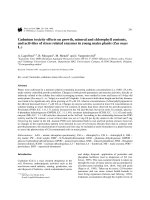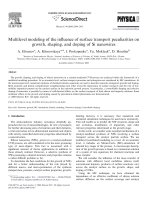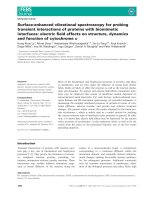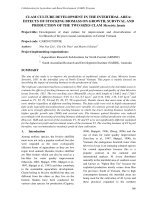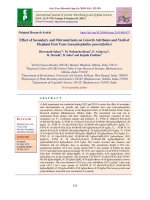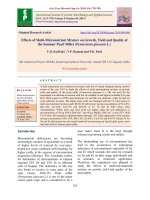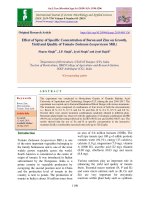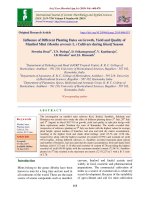Cd toxicity effects on growth, mineral and chlorophyll contents and activities of stress related enzymes
Bạn đang xem bản rút gọn của tài liệu. Xem và tải ngay bản đầy đủ của tài liệu tại đây (236.31 KB, 10 trang )
Plant and Soil 200: 241–250, 1998.
© 1998 Kluwer Academic Publishers. Printed in the Netherlands.
241
Cadmium toxicity effects on growth, mineral and chlorophyll contents,
and activities of stress related enzymes in young maize plants (Zea mays
L.)
A. Lagriffoul
1,3
, B. Mocquot
1
, M. Mench
1
and J. Vangronsveld
2
1
Agronomy Unit, INRA Bordeaux Aquitaine Research Center, BP 81, F-33883 Villenave d’Ornon cedex, France
and
2
Limburgs Universitair Centrum, Department SBG, Universitaire Campus, B-3590 Diepenbeek, Belgium.
3
Corresponding author
∗
Received 3 October 1997. Accepted in revised form 4 February 1998
Key words: biomarker, cadmium, maize (Zea mays L.), peroxidase
Abstract
Plants were cultivated in a nutrient solution containing increasing cadmium concentrations (i.e. 0.001–25 µM),
under strictly controlled growth conditions. Changes in both growth parameters and enzyme activities, directly or
indirectly related to the cellular free radical scavenging systems, were studied in roots and leaves of 14-day-old
maize plants (Zea mays L., cv. Volga) as a result of Cd uptake. A decrease in both shoot lengthand leaf dry biomass
was found to be significant only when growing on 25 µM Cd, whereas concentrations of chlorophyll pigments in
the 4th leaf decreased from 1.7 µM Cd on. Changes in enzyme activities occurred at lower Cd concentrations in
solution leading to lower threshold values for Cd contents in plants than those observed for growth parameters.
Peroxidase (POD; E.C. 1.11.1.7) activity increased in the 3rd and 4th leaf, but not in roots. In contrast, glucose-
6-phosphate dehydrogenase (G6PDH; E.C. 1.1.1.49), isocitrate dehydrogenase (ICDH; E.C. 1.1.1.42) and malic
enzyme (ME; E.C. 1.1.1.40) activities decreased in the 3rd leaf. According to the relationship between the POD
activity and the Cd content, a toxic critical value was set at 3 mg Cd per kg dry matter in the 3rd leaf and 5 mg
Cd per kg dry matter in the 4th. Anionic POD were determined both in root and leaf protein extracts; however,
no changes in the isoperoxidase pattern were detected in case of Cd toxicity. Results show that in contrast with
growth parameters, the measurement of enzyme activities may be included as early biomarkers in a plant bioassay
to assess the phytotoxicity of Cd-contaminated soils on maize plants.
Abbreviations: AAS – atomic absorption spectrometry, Chl a – chlorophyll a, Chl b – chlorophyll b, DM –
dry matter, FW – fresh weight, DMF – N,N-dimethylformamide, GDH – glutamate dehydrogenase, G6PDH –
glucose-6-phosphate dehydrogenase, GPOD – guaiacol-peroxidase, GSH – reduced glutathione, HNS – Hoagland
nutrient solution, ICDH – isocitrate dehydrogenase, L3 – third leaf, L4 – fourth leaf, ME – malic enzyme, POD –
peroxidases, SOD – superoxide dismutases
Introduction
Cadmium (Cd) is a trace element ubiquitous in the
soil. However, anthropogenic activities such as the
non-ferrous metal industry, mining, production, use
and disposal of batteries, metal-contaminated wastes
∗
FAX No: (33) 556 84 30 54.
E-mail:
and sludge disposal, application of pesticides and
phosphate fertilizers lead to dispersion of Cd (Al-
loway, 1995). This non-essential element is taken up
through the roots of many species and accumulated in
all plant parts including root, shoot, fruit and grain
(Page et al., 1981). Taken up in excess, Cd becomes
poisonous and can cause serious health hazards to
most living organisms (Jackson and Alloway, 1992).
Cadmium accumulation through the trophic levels of
242
the food chain constitutes a risk for humans (Wagner,
1993).
The potential phytotoxicity of Cd-contaminated
soils is usually monitored by chemical analysis and
germination tests. Data from chemical analyses pro-
vide an estimate of bothtotal Cd contentin the soil and
its extractability, but yielding no information on either
the fraction of Cd available to plants or the amount
taken up by roots and translocated to the aerial parts.
Phytotoxicity is due to interference with metabolic
processes in plants (Van Assche et al., 1988). Mecha-
nisms and effects of phytotoxicity must thus be consid-
ered. The dose-response relationships established up
to now by agronomists in plant bioassays for the eval-
uation of metal contaminated soils are mainly based
on visual symptoms, such as chlorosis, necrosis, leaf
epinasty and red-brownish discoloration, on biomass
reduction, yield decrease and changes in mineral com-
position (Van Assche and Clijsters, 1990a). However,
these types of symptoms mostly characterize high lev-
els of phytotoxicity. These approaches are insufficient
to evaluate the soil quality. A better understanding of
the Cd effects on plants needs to concern much more
sensitive parameters, such as cellular metabolic com-
pounds that may reflect, specifically if possible, the
physiological and biochemical state of the plant.
Cd directly or indirectly inhibits physiological
processes such as respiration, photosynthesis, water
relations and gas exchange (Van Assche and Cli-
jsters, 1990a). Cd may be preferentially accumulated
in chloroplasts. Photosynthesis is inhibited at several
levels: CO
2
-fixation, stomatal conductance, chloro-
phyll synthesis, electron transport and enzymes of
the Calvin cycle (Ernst, 1980). Changes in cellular
metabolism can be observed even at low levels of
Cd, before visual symptoms become evident. Enzyme
activities have been used as early diagnostic criteria
to evaluate the phytotoxicity of metal-contaminated
soils (Mench et al., 1994; Vangronsveld and Clijsters,
1994). One of the main toxic effects of trace met-
als, such as copper (Cu) and Cd is oxidative stress,
linked with a lipid peroxidation of cellular membranes
(De Vos et al., 1991; Ernst et al., 1992). Oxidative
stress is defined as all of the effects such as cellu-
lar damage, caused by the active forms of oxygen
such as superoxide (O
·−
2
), hydrogen peroxide (H
2
O
2
),
hydroxyl radical (OH
·−
) and singlet oxygen (
1
O
2
)
(Kappus, 1985). Lipophilic (carotenoids, tocopherols)
or water-soluble antioxidants (ascorbate, glutathione),
and many scavenging enzymes such as POD, SOD
and catalases enable the cell to quench these reac-
tive oxygen species (Polle and Rennenberg, 1994).
Peroxidases induction is a general response in higher
plants to the uptake of toxic amounts of metals, and is
likely to be related to oxidative reactions at the plasma
membrane. Peroxidases induction has been correlated
with the level of Zn and Cd in bean (Van Assche et
al., 1988) and to the level of Cu in maize (Mocquot
et al., 1996). Enzymes involved in the intermediary
metabolism are also altered by toxic amounts of Zn
and Cd in bean (Van Assche et al., 1988), e.g. ME,
ICDH, GDH and G6PDH. Ernst (1980)suggested that
the activity of these enzymes directly or indirectly
involved in the respiratory Krebs cycle and pentose
phosphate pathway is possibly stimulated to compen-
sate for the decrease of ATP and NADPH normally
provided by the metal-sensitive photosynthetic reac-
tions. According to Slaski et al. (1996), the pentose
phosphate pathway could play a role in mediating
metal resistance, since several of its intermediates,
such as pentoses, erythrose 4-phosphate and NADPH,
are precursors in the synthesis of substances poten-
tially involved in the alleviation of metal stress (amino
acids, nucleic acids, coenzymes and lignin).
Studies on Cd toxicity in maize seedlings have
largely been concerned with photosynthesis (Feretti
et al., 1993), but data on Cd-induced changes in en-
zyme activities related to either energetic or tolerance
metabolism are scarce. In this paper, the effects of Cd
uptakeand partitioning in maizerootsand leaves, from
plant grown in hydroponic culture, were investigated
using enzymes involved in the antioxydant defence,
i.e. GPOD, SOD, and in the intermediary metabolism,
i.e. ME, ICDH, G6PDH and GDH.
Materials and methods
Plant growth and plant samples analysis
Plant growth conditions, measurements and analysis,
were performed as described previously (Mocquot et
al., 1996). Zea mays L. cv. Volga seeds were surface-
sterilized with hydrogen peroxide 3% (vol/vol), and
rinsed with distilled water. Following germination on
filter paper soaked with 2 mM CaSO
4
, seedlings were
transferred to a modified HNS that was continuously
aerated and renewed every two days. Cd(NO
3
)
2
was
added to the HNS after a two-day acclimation phase,
at concentrations derived from a preliminary study:
1, 5, 10, 25, 50, 100, 250, 500, 700 nM and 1,
1.7, 3, 5, 10 and 25 µM. Plants were cultivated in
243
a growth chamber at the following conditions: 25/20
◦
C day/night temperature, 75% relative humidity, 16/8
h photoperiod and 400 µmol m
−2
s
−1
photosynthetic
photon flux density at leaf level.
Plants were harvested 11 days after germination,
when they reached the stage of full expansion of the
L4. Growth parameters were measured immediately:
i.e. shoot length, length and width of each leaf. The
leaf area was calculated according to Mocquot et al.
(1996). After extraction with DMF, Chl a, Chl b and
total carotenoids were measured spectrophotometri-
cally (Varian Cary 1E) in the extracts from the L4 at
470, 647 and 664.5 nm respectively, as described by
Lichtenhaler and Wellburn (1983), and Blanke (1990).
Each plant was divided into roots, L3, L4 and the
remaining shoots. The fresh weight of all plant parts
was determined. Each organ (1 g FW) was sampled
twice, immediatly frozen in liquid nitrogen and stored
at −80
◦
C. The remaining tissues were oven-dried at
80
◦
C for DM determination and then wet digested
in nitric acid and hydrogen peroxide. Cadmium con-
centrations were determined by AAS (Varian A 20)
or by graphite furnace AAS with Zeeman and deu-
terium corrections(Varian A 400). Phosphorus, K, Ca,
Mg, Fe, Mn and Zn concentrations were measured
by inductively coupled plasma emission spectrometry
(Varian Liberty 200). Controls were performed using
blanks and a reference material (ryegrass BCR 281,
Community Bureau of Reference, Commission of the
European Communities) treated in the same way. Only
one determination of the concentrationof Cd andother
elements was realised per sample. All the used chemi-
cals were purchased from Prolabo (Normapur),except
Cd(NO
3
)
2
and HNO
3
purchased from Merck (Pro
Analysi).
Enzyme assays and isoenzymes determination
Frozen material (1 g FW) was homogenized with
an ice-cooled mortar and ground in 5 mL of 0.1
M Tris-HCl buffer (pH 7.8) containing 1 mM DTT
and1mMEDTA, and centrifuged at 12,000 g (4
◦
C for 10 min). The supernatants were collected and
the activities of the following enzymes were mea-
sured spectrophotometrically (Mocquot et al., 1996):
POD (E.C.: 1.11.1.7), ME (E.C.: 1.1.1.40), G6PDH
(E.C.: 1.1.1.49),GDH (E.C.: 1.4.1.2) and ICDH (E.C.:
1.1.1.42). Guaiacol was used for the determination
of total POD activity, which is expressed as mU per
g FW. One unit (U) equals the amount of substrate
(µmol) transformed by the enzyme in one minute at
30
◦
C. Total soluble proteins were determined using
the Bio-Rad protein assay and expressed as mg protein
per g FW.
Anionic (iso)peroxidases were separated by poly-
acrylamide gel electrophoresis on a 7.5/20% gradient
slab gel, and stained enzymatically with 0.04% ben-
zidine and 0.006% H
2
O
2
for1.5hat37
◦
C(Van
Assche and Clijsters, 1990b). The gels were scanned
densitometrically at 632 nm.
Data processing
The x,y data sets were curve-fitted by the Fig.P pro-
gramme (Biosoft, Ferguson, USA). The threshold
values for Cd phytotoxicity were defined as the con-
centration in the plant tissue above which growth was
reduced or metabolism changed (±10%). It was cal-
culated from the intersection of the two straight lines,
obtained after plotting the logarithm of the studied
parameter against the logarithm or the reciprocal of
Cd content in plant tissue (Mocquot et al., 1996).
Correlations between variables were calculated with
STATITCF 4.0 (ITCF, Boigneville, F.). Data for the
morphological parameters were analysed using a con-
ventionalanalysisof variance,and the Newman–Keuls
test at the 5% level.
Results
Growth and Cd concentration in plant tissues
Increasing the Cd concentration of the HNS led to
an increase in Cd content of all maize organs (Fig-
ure 1). The Cd concentration ranged from 0.7 to 304
mg kg
−1
DM in roots, from 0.3 to 123 mg kg
−1
DM in L3, and from 0.13 to 73 mg kg
−1
DM in L4.
The Cd content in plant tissues increased curvilinearly
with the Cd concentration of the nutrient solution. The
curve plots were best fitted by the classical Michaelis–
Menten function Y = Cm ∗ X / (Km + X), where Cm
= maximum tissue concentration (mg kg
−1
DM), Km
= affinity coefficient (µM), Y = Cd concentration in
plant and X = Cd concentration in the HNS. Values
for these kinetic parameters were estimated from the
curvilinear relationships (Figure 1) for roots (Km =
1.7, Cm = 336, r
2
= 0.99), for L3 (Km = 6.5, cm =
147, r
2
= 0.98) and for L4 (Km = 4.9, Cm = 82, r
2
=
0.98).
No visual symptoms of Cd toxicity were observed
in any organ of the seedlings grown on Cd concen-
trations ranging from 1 nM to 10 µM. No significant
244
Figure 1. Cd concentrations (mg kg
−1
DM) in L3, L4 and roots
of Zea mays L. cv. Volga after two weeks of growth in a modified
Hoagland nutrient solution with increasing Cd concentrations.
changes in any of the morphological parameters stud-
ied occured, i.e. root and leaf weight, plant height
and leaf area. The mean values for plants grown on
1.7 µM Cd in the HNS were lower than those for
plants cultivated at lower Cd concentrations. How-
ever, the decrease was only statistically significant (p
≤ 0.05) above 25 µM Cd in the HNS. Plants exposed
to 25 µM Cd showed a significant decrease in shoot
length and in fresh weight, when the tissue Cd content
reached 123 mg kg
−1
DM in L3 and 73 mg kg
−1
DM
in L4 (Figures 2a, b). Leaf area was reduced at 25
µM Cd in L3 only (Figure 2a). In contrast, a linear
ratio between fresh and dry weights with increasing
Cd contents in plant tissues shows that water content
and dry matter in leaves and roots were not signifi-
cantly changed at any of the Cd concentrationsstudied
(data not shown). Chlorophyllpigments extracted with
DMF from L4 showed a decrease. This effect was ob-
served prior to effects on morphological parameters
(Figure 3). Sharp decreases in Chl a, Chl b and in
total carotenoid contents of L4 were observed when
Cd concentrations exceeded 17 mg Cd kg
−1
DM.
Protein contents
The total soluble protein content was examined in leaf
and root samples. Roots and L4 showed no significant
changes in response to the Cd accumulation. Mean
values were 1.4 ± 0.2mgg
−1
FW in roots and 10.2
± 1.3mgg
−1
FW in L4. Maize roots contain less
soluble protein than leaves. Significant changes in L3
were found. The total soluble protein content of L3
gradually increased from about 4 to 10 mg g
−1
FW,
up to a Cd concentration of 13 mg kg
−1
DM (Figure
Figure 2. Changes in morphological parameters, i.e. (a) shoot
length (cm) and L3 area (cm
2
) and (b) L3 and L4 yield (g) of Zea
mays L. cv. Volga in relation to Cd concentrations in a modified
Hoagland nutrient solution or logarithm of Cd concentrations in
plant parts.
4). A constant level of protein about 9 mg g
−1
FW was
then maintained.
Enzyme activities and isoenzyme analysis
The activities of the several enzymes were correlated
with the leaf Cd content either positively (induction),
POD in L3 and L4 (Figures 5a, b), or negatively
(inhibition), ICDH, ME and G6PDH in L3 only (Fig-
ures 5c–e). In maize roots and leaves, the activity
of GDH was not modified by Cd accumulation (data
not shown). Foliar POD activity was higher with in-
creasing Cd concentrations (Figures 5a, b), whereas
no changes were observed in roots (data not shown).
245
Figure 3. Changes in the contents (mg m
−2
) of (a) chlorophyll A,
chlorophyll B and (b) carotenoid in L4 of Zea mays L. cv. Volga in
relation to the logarithm of Cd concentrations in the tissue, after two
weeks of growth in a modified Hoagland nutrient solution.
Figure 4. Changes in total protein contents (mg g
−1
FW) in L3 of
Zea mays L. cv. Volga in relation to the logarithm of Cd concen-
trations, after two weeks of growth in a modified Hoagland nutrient
solution.
In contrast, the activities of the NAD(P)H-reducing
enzymes such as G6PDH, ICDH and ME were de-
creased, but only in L3 (Figures 5c–e). In L4, no
significant effects on enzyme activities related to inter-
mediary metabolism were observed (data not shown).
In roots, the activities of all the enzymes studied were
constant despite Cd increase in this tissue (data not
shown). No significant changes in SOD activities were
observed in the samples (data not shown). For all
enzymes showing a correlation with Cd content in
plant tissue, a quadratic function fitted best with the
experimental data. Threshold values for leaf Cd con-
tents, above which enzyme activity either increased or
decreased are shown in Table 1.
According to Van Assche et al. (1988), and in con-
trast to Figures 5a, b, plotting the logarithm of enzyme
activity against the reciprocal of Cd content in the tis-
sue allows the calculation of the Cd threshold value of
enzyme induction. Cadmium threshold value for POD
induction in maize L3 is shown as an example (Figure
6). Apparently, POD activity was stimulated when Cd
exceeded 3 mg kg
−1
DM in L3 and 5 mg kg
−1
DM
in L4 (data not shown). As a result of Cd toxicity,
the activities of several enzymes involved in or closely
related to the Krebs cycle were significantly decreased
in L3. Losses in activity were observed from about 15
mg Cd kg
−1
DM for G6PDH (Figure 5e) and 22 mg
Cd kg
−1
DM for ICDH (Figure 5c). In L4, the activity
of these enzymes tends to decrease at the highest tissue
Cd concentration, but these data were not significantly
different from each others (data not shown).
Cd-induced changes in total POD activity in leaves
were not reflected in changes in the pattern of isoen-
zymes. In constrast to Cu (Mocquot et al., 1996), gels
stained for POD activity did not show induction of
specific (iso)peroxidases either in leaves or in roots,
even at the highest Cd concentration.
Mineral composition of plant tissues
The contents of essential elements (P, K, Mg, Fe, Zn,
Mn, Cu and Ca) were not significantly modified by Cd
treatment. Data concerning mean concentrations and
standard errorsfor these elements are given in Table 2.
The effects of Cd on the concentrations of P and Mn
in maize are given in Figures 7a, b, respectively. With
increasing Cd accumulation, Mn contents were lower
in both leaves and roots, while P contents increased
only in leaves. For both elements, significant changes
occured above 1.7 µM Cd. The concentration of these
246
Figure 5. Enzyme activities (mU g
−1
FW) in leaves of Zea mays L. cv. Volga as a function of the logarithm of Cd concentrations in the
leaves: (a–b) (guaiacol)-peroxidase in L3 and L4, (c) isocitrate dehydrogenase in L3, (d) malic enzyme in L3 and (e) glucose-6- phosphate
dehydrogenase in L3.
elements, except Mg, was higher in L3 than in L4,
especially Ca (data not shown).
Discussion
Morphological toxicity symptoms were only observed
at high Cd concentrations in leaf and root tissues (Ta-
ble 1). Compared to data obtained with copper on the
same maize cultivar and grown under exactly the same
conditions (Mocquot et al., 1996), threshold values of
tissue metal concentrations at which plant growth was
significantly inhibited were 3–7 times higher. Metal
threshold values for shoot length reduction were 27
and14mgkg
−1
DM in Cu-treated L3 and L4 respec-
tively, compared to 123 and 73 mg kg
−1
DM in the
same organs treated with Cd (Table 1). These results
suggest that maize is more tolerant to Cd than to Cu.
In another maize cultivar, Galli et al. (1996) reported
a strong reduction in root dry weight for a root Cd
247
Table 1. Toxic threshold values (mg Cd kg
−1
DM) calculated from
the functions fitting the relationship between either growth para-
meters, chlorophyllous pigments, total protein contents or enzyme
activities and Cd concentrations in the tissues of Zea mays L. cv.
Vo lg a
Plant organs
Roots Third leaf (L3) Fourth leaf (L4)
Growth parameters
Shoot length 304 123 73
Leaf area ns ns
Leaf yield 123 73
Root yield ns
Total upper parts 76 48
Total upper parts 123 73
Chlorophyllous pigments
Chlorophyll a nd 28
Chlorophyll b nd 28
Total carotenoids nd 28
Enzyme activity
POD ns 3 5
ICDH ns 22 ns
G-6PDH ns 15 ns
ME ns 20 ns
GDH ns ns ns
ns: not significant.
nd: not determined.
Figure 6. Logarithm of peroxidase activity in tissue extracts plotted
against the reciprocal of Cd concentration in L3 of Zea mays L. cv.
Volga, after two weeks of growth in a modified Hoagland nutrient
solution.
Table 2. Mineral concentrations (mg kg
−1
DM) in plant organs of
maize (Zea mays L. cv. Volga) cultivated in a modified Hoagland nu-
trient solution with Cd concentration ranging from 0.001 to 25 µM:
mean and standard deviation values across treatment for element
concentrations showing no significant change
Plant organs
Roots Third leaf (L3) Fourth leaf (L4)
Potassium (K) 53024 ± 5952 69364 ± 3005 61850 ± 3882
Magnesium (Mg) 2344 ± 281 953 ± 76 1126 ± 69
Iron (Fe) 5200 ± 810 101 ± 11 79 ± 25
Zinc (Zn) 35 ± 833±832±10
Copper (Cu) 15 ± 214±29±2
Calcium (Ca) 4099 ± 666 3436 ± 353 1684 ± 197
Figure 7. Phosphorus (a) and manganese (b) concentrations (mg
kg
−1
DM) in L3, L4 and roots of Zea mays L. cv. Volga after
two weeks of growth in a modified Hoagland nutrient solution with
increasing Cd concentrations.
248
concentration of 562 mg kg
−1
DM. This was higher
that Cd concentration found in the present study (304
mg kg
−1
DM for the highest Cd treatment).
Bean seedlings seem to be less tolerant to Cd than
maize seedlings. For morphological parameters only,
a Cd threshold value of 5.5 mg kg
−1
DM in pri-
mary leaves of bean was found (Van Assche et al.,
1988). This suggests that maize plants seem to possess
other and/or more efficient detoxification mechanisms
to deal with Cd toxicity than bean, including metal-
accumulation, binding and inactivation, and oxidative
stress scavenging systems.
The increased metal concentrations in the tissues
cause increased activities of some enzymes (induc-
tion) either as a result of de novo protein synthesis or
by the activation of enzymes already present in plant
cells (Van Assche and Clijsters, 1990a). Changes in
SOD and POD activities, and in the (iso)SOD and
(iso)POD patterns have been reported both in leaves
and roots of bean plants as a result of Cd toxicity (Van
Assche et al., 1988). The ‘stress point’ is defined as
the metabolic state where the regulation of pathways
towards positive direction for plant fitness is at its lim-
its (Elstner et al., 1988), and is probably reached at
the toxic threshold level of the metal in the tissue (Van
Assche and Clijsters, 1990a).
The high affinity of metals for sulphydryl groups
(-SH) is suggested to be one of the main mecha-
nisms of enzyme inhibition (Karataglis et al., 1991;
Weigel and Jäger, 1980). Measured decreases in en-
zymes of intermediary metabolism (G6PDH, ICDH
and ME) contrast with previous observations. Induc-
tion of ICDH, GDH, G6PDH and ME activity has
been reportedin bean leaves (Van Assche et al., 1988).
Cadmium threshold values were calculated to be 3.1,
4.6, 5.5 and 7.4 mg kg
−1
DM, respectively for GDH,
ME, ICDH and G6PDH induction. In soybean treated
with toxic concentrations of Cd and Pb, a similar in-
crease has been reported (Lee et al., 1976). A rapid
increase in G6PDH activity has been shown by Slaski
et al. (1996) in resistant cultivars of wheat treated with
Al and in silene treated with Zn (Mathys, 1975). In
contrast, the same author reported a total inhibition
of G6PDH activity in isolated preparations of this en-
zyme treated with Zn. A review of existing data on the
induction of enzymes of the intermediary metabolism
by several metals is given by Vangronsveld and Cli-
jsters (1994). The fact that these enzymes seem to
be inhibited by Cd in maize suggests that enzyme
responses can vary between plant species and metal
treatments. In principle, two main mechanisms of en-
zyme inhibition can occur: (1) binding of the metal to
sulfhydryl groups, involved in the catalytic action or
structural integrity of enzymes, and (2) deficiency of
an essential metal in metalloprotein complexes, com-
bined with the substitution of the toxic metal for the
deficient element. ICDH and ME require Mn
+2
ions
for activity, so Mn deficiency could act as a limiting
factor for ICDH and ME activity. Cd-induced Mn-
deficiency in leaves and roots (vide infra) (Figure 7b)
could be responsible for the inhibition of these two en-
zymes in maize leaves. However, the threshold value
for Mn
+2
decrease in leaves appeared at higher Cd
concentrations than the threshold values for enzyme
inhibition. Similary, G6PDH requires Mg
+2
ions for
activity, but no significant change in Mg
+2
content
were observed in maize leaves or roots in response to
the Cd accumulation (data not shown). Cho and Joshi
(1989) found that the loss of G6PDH activity in baker
yeast was due to conformational changes in protein
structure by metal-binding to the carboxyl or hydroxyl
groups of the enzyme. Our data do not discriminate
between the relative importance of direct effects on
enzymes, substrate limitation or feedback regulation.
The chlorophyll pigment contents found in Cd-
contaminated maize L4 are similar to those reported
by Mocquot et al. (1996) in young plants treated
with Cu. In comparison with the critical values for
leaf yield or shoot length reduction of the L4 (Ta-
ble 1), the decrease in chlorophyll and carotenoid
contents appears to be one of the first visible biomark-
ers of Cd toxicity. Two possible mechanisms of Cd
toxicity on photosynthesis have been proposed to ex-
plain the decrease in chlorophyll pigments. Cadmium
can alter both chlorophyll biosynthesis by inhibiting
protochlorophyllide reductase and the photosynthetic
electron transport by inhibiting the water-splitting en-
zyme located at the oxidising site of photosystem
II (Van Assche and Clijsters, 1990a). Interactions
with SH groups are involved in the inhibition of pro-
tochlorophyllide reductase by Cd. Since Mn is essen-
tial for optimal water-splitting activity (Baszinsky et
al., 1980) the interaction observed between Cd and
Mn in the whole maize plant (see Figure 7b) could
possibly explain the inhibition of electron transport at
the level of the water-splitting complex and hence the
decrease in chlorophyll pigment contents.
In constrast to the high threshold values for inhi-
bition of morphological parameters, POD activity was
induced at the low tissue Cd concentrations of 3 and 5
mg kg
−1
DM in L3 and L4 respectively (Table 1). This
is comparable to the Cd threshold values previously
249
found for POD in primary bean and soybean leaves
which were reported to be 5.5 mg kg
−1
DM (Van Ass-
che et al., 1988)and 3 mg kg
−1
DM (Lee et al., 1976),
respectively. Since morphologicalparametersin maize
are only affected at much higher tissue Cd contents,
POD activation is a important event in Cd-induced
acclimation. Induction of POD is a general stress re-
sponse and is not specific to metals. The hypothesis
that Cd induces a more general physiological reaction
involving formation of H
2
O
2
and/or organic peroxides
(Elstner et al., 1988) is supported by these observa-
tions. During stress, oxygen derivatives accumulate
and this results in the induction of enzymes such as
POD, SOD and catalases (Creissen et al., 1994). These
enzymes provide antioxidant protection and preserve
membrane integrity. The removal of H
2
O
2
produced
in chloroplasts is essential to avoid inhibition of the
Calvin cycle enzymes (Tanaka et al., 1982). Peroxi-
dases transform peroxide into water using an electron
donor (R) which is oxidized during catalysis: RH
2
+
H
2
O
2
⇒ R+2H
2
O. Electron donors such as ascor-
bate, glutathione, guaiacol and many other reduced
compounds are involved in POD reactions.
Several reports have shown that the addition of Cd
to soils culture decreases the Mn concentration in tis-
sues of radish (Khan and Frankland, 1983) and oat
(Bjerre and Scierup, 1985). Jalil et al. (1994) reported
that 0.5 µM Cd in a nutrient solution significantly
decreases the Mn and Zn concentrations in the roots
and theshoots of durumwheat. A significant reduction
in biomass as a result of Cd application proposed by
these authors to explain the similar decrease in Fe and
Cu contents in wheat can not be extrapolated to ex-
plain the Mn depletion observed in the present study.
However, the distinctive decrease in Mn and Zn con-
centrations in wheat observed at 0.5 µM Cd in the
solution may have been due to competition between
Zn, Mn and Cd for transport across the plasmalemma.
Below critical values, no competition occurred, but
above 0.5 µM Cd in the HNS, tissue Cd concen-
trations became 2.5 higher than that of Mn and Zn,
and competition may occur on transport sites on the
plasmalemma. Alternative explanations are however
possible. According to Khan and Khan (1983), Fe and
Mn concentrationsincrease significantlyin tomato and
decrease in egg-plant when Cd is added to the soil
culture. Mn and Fe seem to complex with the same
organic ligands as heavy metals in egg-plant. This in-
teraction at the root surface results in decreased uptake
by the plant. All these reports therefore indicate that
important interactions of Cd with other essential met-
als can occur, either at the root surface or at the plasma
membrane of root cells.
Conclusions
The variations on growth and mineral contents of
Cd-contaminated maize seedlings are not a sensitive
parameter to evaluate the consequences of Cd uptake.
Changes on morphological parameters occurred only
at the highest metal concentration studied. Moreover,
the evaluation of a Cd-induced oxidative stress us-
ing as biomarkers the enzyme activities involved in
the intermediary metabolism seems to be rather in-
direct. The first defensive mechanism from oxidative
stress is the scavenging of activated oxygen species at
the sites where they are generated, especially chloro-
plasts where Cd accumulates. The chlorophyll and
carotenoid decreases at relatively low Cd concentra-
tion can be indicative of a damage at the chloroplast
level. The evaluation of the enzyme activities less or
more directly linked to the respiratory Krebs cycle
should be useful to evaluate the general and secondary
effects of Cd toxicity on metabolic processes, but not
to test the real induction of an early oxidative stress.
The determination of scavenging enzyme activities,
antioxidative compounds (ascorbate and glutathione)
and primary toxic compoundssuchas hydrogenperox-
ide could give more precise information on the induc-
tion of an activated oxygen-induced stress. All these
compounds will be investigated in further studies.
Acknowledgements
The authors would like to thank Prof. C Foyer for
critical reading of the manuscript and fruitful cor-
rections. We are very grateful to Mrs S Bussière
and Mr T Prunet from INRA Agronomy Unit, Bor-
deaux, France, for technical assistance. This work
was supported by grants from Institut National de
la Recherche Agronomique, Secteur Environnement
Physique & Agronomie.
References
Alloway B J 1995 Heavy Metals in Soils, 2nd ed. Blackie Academic
& Professional Publishers, London. 368 p.
Baszinsky T, Wajda L, Krol M, Wolinska D, Krupa Z and Tukendorf
A 1980 Photosynthetic activities of cadmium treated tomato
plants. Physiol. Plant. 48, 365-370.
250
Bjerre G K and Schierup H 1985 Uptake of six heavy metals by oat
as influenced by soil type and additions of cadmium, lead, zinc
and copper. Plant Soil 88, 57–69.
Blanke M M 1990 Determination of chlorophyll with DMF. Vitic.
Enol. Sci. 45, 76–78.
Cho S W and Joshi J G 1989 Inactivation of baker’s yeast glucose-
6-phosphate dehydrogenase by aluminium. Biochemistry 28,
3613–3618.
Creissen G P, Edwards E A and Mullineaux P M 1994 Glutathione
reductase and ascorbate peroxidase. In Causes of Photooxidative
Stress and Amelioration of Defense Systems in Plants. Eds. C
H Foyer and P M Mullineaux. pp 344–361. CRC Press, Boca
Raton, Florida.
De Vos C H R, Schat H, De Waal M A M, Vooijs R and Ernst W H O
1991 Increased resistance to copper induced damage of the root
cell plasmalemma in copper-tolerant Silene cucubalus. Physiol.
Plant. 82, 523–528.
Elstner E F, Wagner G A and Schutz W 1988 Activated oxygen
in green plants in relation to stress situations. Curr. Top. Plant
Physiol. Biochem. 7, 159–187.
Ernst W H O 1980 Biochemical aspects of cadmium in plants. In
Cadmium in the Environment. Ed. J O Nriagu. pp 639–653.
Wiley and Sons, New York.
Ernst W H O, Verkleij J A C and Schat H 1992 Metal tolerance in
plants. Acta Bot. Neer. 41, 229–248.
Ferretti M, Ghisi R, Merlo L, Dalla Vecchia F and Passera C 1993
Effect of cadmium on photosynthesis and enzymes of photosyn-
thetic sulphate and nitrate assimilation pathways in maize (Zea
mays L.). Photosynthetica 29, 49–54.
Galli U, Schüepp H and Brunold C 1996 Thiols in cadmium and
copper-treated maize (Zea mays L.). Planta 198, 139–143.
Jackson A P and Alloway B J 1992 The transfer of cadmium from
agricultural soils to the human food chain. In Biogeochemistry of
Trace Metals. Ed. D C Adriano. pp 109–158. CRC Press, Boca
Raton, Florida, USA.
Jalil A, Selles F and Clarke J M 1994 Growth and Cd accumulation
in two durum wheat cultivars. Commun. Soil Sci. Plant Anal. 25,
2597–2611.
Kappus H 1985 Lipid peroxidation: mechanisms, analysis, enzy-
mology and biochemical relevance. In Oxidative Stress. Ed. H
Sies. pp 273–310. Academic Press I l.c., London.
Karataglis S, Moustakas M and Symeonidis L 1991 Effect of heavy
metals on isoperoxydases of wheat. Biol. Plant. 33, 3–9.
Khan S and Khan N S 1983 Influence of lead and cadmium on
the growth and nutrient concentration of tomato (Lycopersicon
esculentum) and egg-plant (Solanum melongena). Plant Soil 74,
387–394.
Khan D H and Frankland B 1983 Effects of cadmium and lead on
radish plants with particular reference to movement of metals
through soil profile and plant. Plant Soil 70, 335–345.
Lee K C, Cunningham B A, Paulsen G M, Liang G H and Moore R
B 1976 Effects of cadmium on respiration rate and activities of
several enzymes in soybean seedlings. Physiol. Plant. 36, 4–6.
Lichtenhaler H K and Wellburn A R 1983 Determination of total
carotenoids and chlorophylls a and b of leaf extracts in differ-
ent solvents. Biochem. Soc. Trans. 603rd Meeting, Liverpool 11,
591–592.
Mathys W1975 Enzymes of heavy-metal-resistant and non-resistant
populations of Silene cucubalus and their interaction with some
heavy metals in vitro and in vivo. Physiol. Plant. 33, 161–165.
Mench M, Martin E and Solda P 1994 After effects of metals de-
rived from a highly metal-polluted sludge on maize (Zea mays
L.). Water Air Soil Pollut. 75, 277–291.
Mocquot B, Vangronsveld J, Clijsters H and Mench m 1996 Copper
toxicity in young maize (Zea mays L.) plants: effects on growth,
mineral and chlorophyll contents, and enzyme activities. Plant
Soil 182, 287–300.
Page A L, Bingham F T and Chang A C 1981 Cadmium. In Effect of
Heavy Metal Pollution on Plants. Vol. 1: Effects of Trace Metals
on Plant Function. Ed. N W Leep. pp 77–109. Applied Science
Publishers, Ripple Road, Barking, Essex, England.
Polle A and Rennenberg H 1994 Photooxidative stress in trees. In
Causes of Photooxidative Stress and Amelioration of Defense
Systems in Plants. Eds. C H Foyer and P M Mullineaux. pp 200–
212. CRC Press, Boca Raton, Florida.
Slaski J J, Zhang G, Basu U, Stephens J L and Taylor g 1996
Aluminium resistance in wheat (Triticum aestivum L.) is asso-
ciated with rapid Al-induced changes in activities of glucose-6-
phosphate dehydrogenase and 6-phosphogluconate dehydroge-
nase in root apices. Physiol. Plant. 98, 477–484.
Tanaka K, Otsubo T and Kondo N 1982 Participation of hydrogen
peroxide in the inactivation of Calvin cycle SH enzymes in SO
2
-
fumigated spinach leaves. Plant Cell Physiol. 23, 1009–1018.
Van Assche F, Cardinaels C and Clijsters H 1988 Induction of
enzyme capacity in plants as a result of heavy metal toxicity;
dose-reponse relations in Phaseolus vulgaris L., treated with zinc
and cadmium. Environ. Pollut. 52, 103–115.
Van Assche F and Clijsters C 1990a Effects of metals on enzyme
activity in plants. Plant Cell Environ. 13, 195–206.
Van Assche F and Clijsters C 1990b A biological test system for
the evaluation of the phytotoxicity of metal contaminated soils.
Environ. Pollut. 66, 157–172.
Vangronsveld J and Clijsters H 1994 Toxic effects of metals.
In Plants and the Chemical Elements. Biochemistry, Uptake,
Tolerance and Toxicity. Ed. M E Farago. pp 149–177. VCH
Verlagsgesellschaft, Weinheim, Germany.
Wagner G J 1993 Accumulation of cadmium in crop plants and its
consequences to human health. Adv. Agron. 51, 173–205.
Weigel H J and Jäger H J 1980 Subcellular distribution and chemical
form of Cd in bean plants. Plant Physiol. 65, 480–482.
Section editor: L V Kochian
